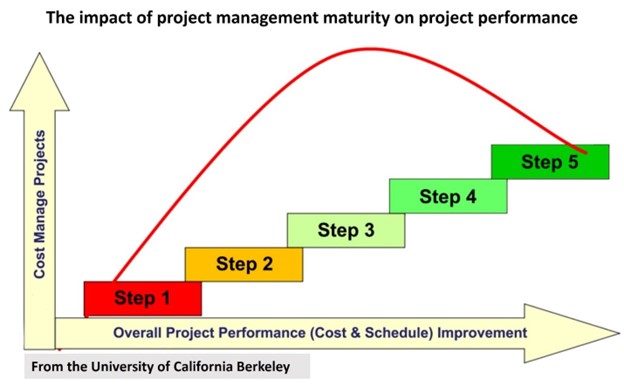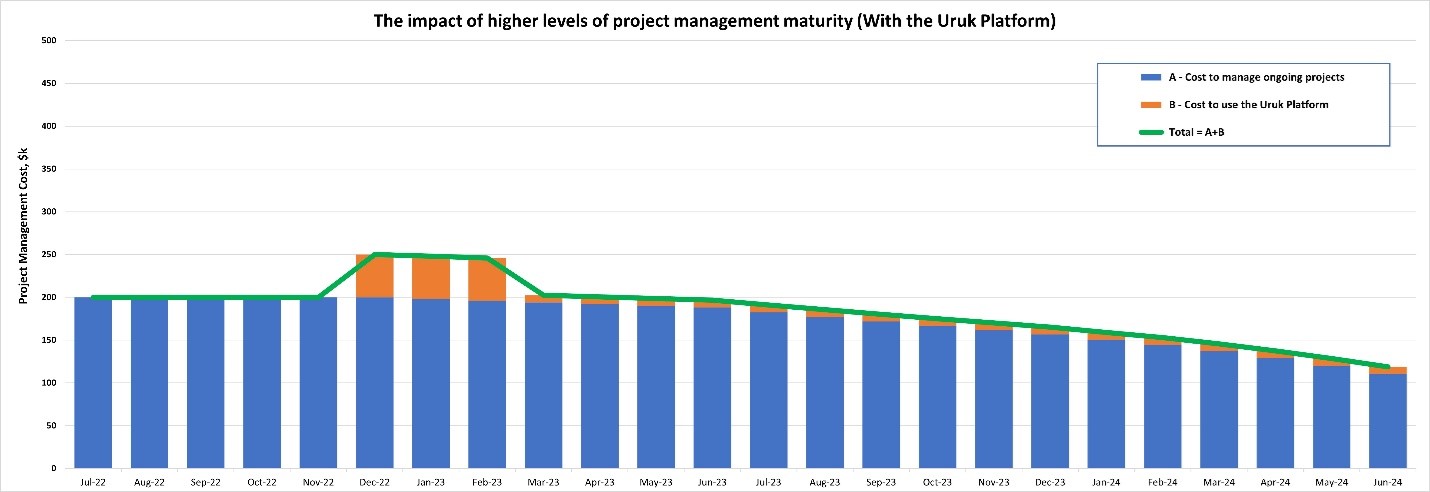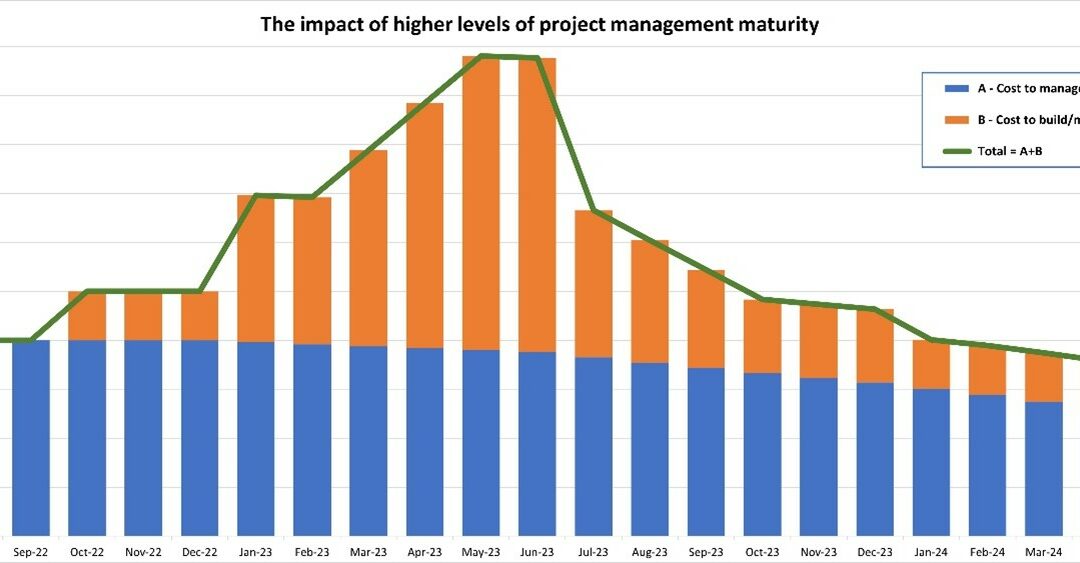How can project management be a competitive advantage?
Previous Post
Recently, we published a post asking, “Can project management be a competitive advantage?” We shared that article on LinkedIn, which generated a few interesting responses. Those responses led us to publish this article with examples and more information.
The project management maturity illustration
Definition: PM Maturity (or Maturity) is short for organizational project management maturity, which is the Maturity of the OPM System and the discipline in following such a system.
The illustration we shared from the University of California Berkeley study led to many questions about the meaning of the Red Line.

Some comments were because of an understanding that the line only represents the cost of managing projects, meaning it should start high and drop gradually. However, that line represents two variables (A and B), as explained below.
The Red Line is = A + B
Variable A: the cost of managing projects
- Variable A is the cost of managing all the projects in an organization.
- It is ongoing and required on every project.
- For organizations that capture the project management costs or competitive advantage, it would be a percentage of the project’s total cost.
- This cost should drop as the organization rises on the maturity scale.
- This drop would be due to improved efficiency and increased competence from the defined OPM System, along with the effect of a learning curve.
The vital message here is that the cost of managing projects decreases with higher organizational project management maturity.
Remember that when we use the word Maturity, it refers to organizational project management maturity. It is not about the competence of the project manager or the project management team.
Variable B: Organizational project management costs
This variable has two parts:
- Part 1 is the initial cost of building the project management function (PMO, OPM System, training, etc.). This would be an investment for organizations with no project management systems (or at a low level of Maturity). The investment would be spent over many months.
- Part 2 is the ongoing support once Part 1 is accomplished. What is included in this cost is highly dependent on the organization. However, this would be the cost of continuous improvement.
Definition: The OPM System includes governance, policies, processes, and methods for managing the organization’s projects. In the broader sense, it includes programs, product delivery, and portfolio.
Remember that both parts in Variable B are about the organizational cost of the project management function and are NOT about the direct cost of managing specific projects. One can think of this as Overhead.
How do we quantify the value leading to a competitive advantage?
Conceptual example
Please note that the percentages we use demonstrate the point and do not reflect actual numbers. As a percentage of total costs, the project management cost will depend on many variables such as domain, project type, size, or complexity.
At Level 1, let us assume that a company spends about 15% of the total project cost on project management (managing a project). It is also possible that the projects still end up 20% over budget and behind schedule.
At Level 2, the project management cost might drop below 15% of the total cost. Further, they might be able to reduce the over-budget or delays.
At Level 3, the project management cost might drop even below 10%. Also, the organization could complete most projects close to budget or schedule.
An organization will achieve significant savings on each project based on the above. Since the organization knows how many projects they do, they can calculate the benefits gained. However, to get to Level 3 from ZERO, they might have to spend $1M to set up the PMO, build the OPM, and train their people. Sooner or later, they will reach the breakeven point (the peak of the red line).
A specific example of how project management can be a competitive advantage?
Here is an example of why this concept works. Think about it!
If we ask a team member to do a project charter.
- At level 0 (the organization has NO systems), the team member (or new project manager) might not know a project charter, so she must search, look for templates, and ask questions. Ultimately, we might end up with a mediocre charter based on external templates that might not align with our work.
- At level 1, she might know what a project charter is but does not know how to do one.
- Also, at level 2, maybe she knows what a charter is and can find some templates.
- At level 3, the organization has a procedure for how to develop a charter. So, it is becoming easier.
- At level 4, the organization has enhanced the procedure (based on practice), and now they have many good examples from past organizational projects.
As one will expect, the time to develop a charter between Levels 0 and 4 or 5 will drop dramatically.
Now, let us extrapolate the above to all other processes and actions. Can you mentally calculate the savings in the time and effort required to manage a project?
What savings are possible?
There are not many independent studies on calculating the impact of the above. Based on the UC Berkeley study and other resources, we know that an effective organizational project management system with the right methodological process can lead to significant cost and time savings.
A revised chart: the impact of project management maturity
This chart is an example with many assumptions. It is not a real case since too many variables will affect this model. However, organizations can do their math. Please let us know if you prefer to see the data for this chart. In this case, the green line replaces the red line in the previous illustration; it is A+B.

Closing remarks – call to action.
Repeating what we shared in the original post of Can Project Management Be a Competitive Advantage, Project challenges and pain points are common, leading to more failures than successes. However, we also know that a higher level of project management maturity makes a huge difference. When adopting the strategic project management mindset, organizations can achieve higher project management maturity. Subsequently,
Project management can be a competitive advantage.
Project management can be indispensable for business results.
Now think about this:
How about achieving these results and improvements without the significant initial investment? In other words, eliminating all or most of the Part 1 costs of Variable B (mentioned earlier).
Do you want to know how? Reach out and talk with our representative. You can also schedule an advisory session with our CEO.
Here is a teaser: compare the two charts to see what is possible!

Seize Project Success with the Uruk Platform’s functionalities.
Empower your Product Delivery Journey from the idea to the Market!
Try it today! ➡️https://lnkd.in/e8zgji9q

